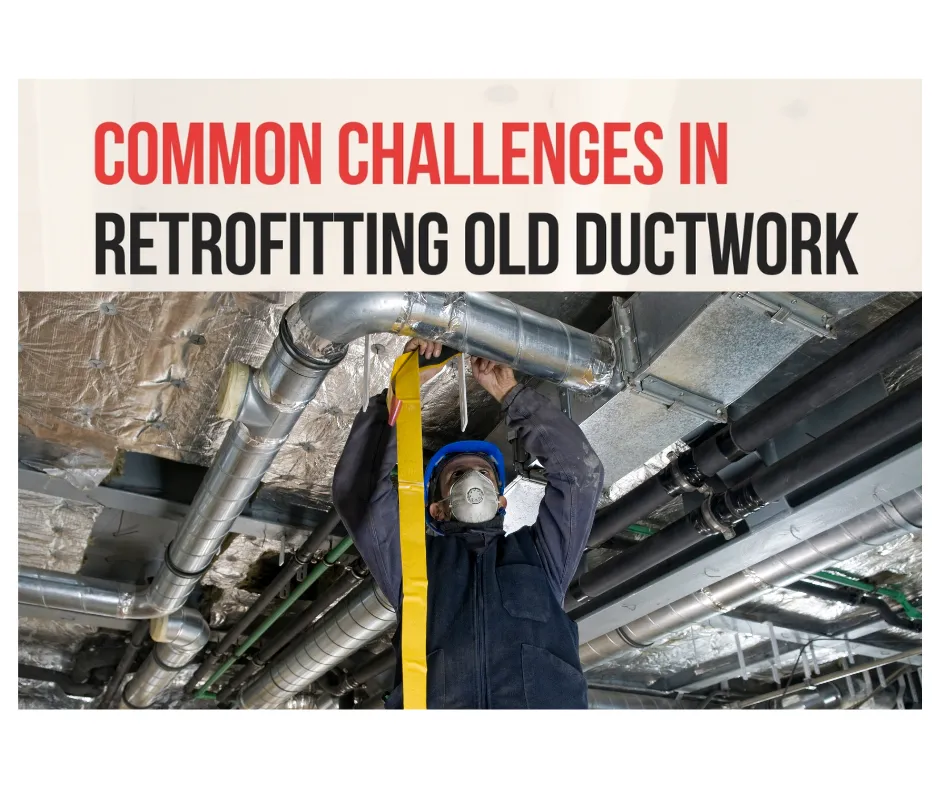Duct Design News and Tips

Common Challenges in Retrofitting Old Ductwork


Common Challenges in Duct Rehabilitation
Retrofitting old ductwork isn’t without its challenges. Here are some of the most common issues you might encounter and how to address them:
1. Limited Space in Older Buildings
Older buildings often have tight spaces that make accessing and replacing ductwork difficult. This is particularly challenging in historic homes or commercial buildings with limited clearance between walls, ceilings, or floors.
Solution: Flexible insulated ducts can be a game changer in tight spaces. These ducts are easier to maneuver and install compared to rigid ductwork. Additionally, they provide excellent insulation, helping improve energy efficiency.
2. Leaks and Poor Sealing
Over time, old ducts can develop leaks at joints and seams, causing significant air loss. According to the U.S. Department of Energy (DOE), leaky ducts can reduce HVAC efficiency by up to 30%.
Solution: During duct rehabilitation, seal leaks with mastic sealant or metal-backed tape. For extensive damage, consider replacing sections of ductwork with modern, flexible insulated ducts to ensure a tighter seal and better efficiency.
3. Outdated or Missing Fire Dampers
Fire dampers are critical safety components designed to prevent the spread of fire through ducts. Unfortunately, many older systems either lack fire dampers or have ones that no longer meet modern building codes.
Solution: Install or upgrade fire dampers to meet current safety regulations. Work with a licensed HVAC professional to ensure proper placement and compliance with fire safety standards. Learn more about fire dampers and their importance from the National Fire Protection Association (NFPA).
4. Inadequate Insulation
Old duct systems often lack proper insulation, leading to energy loss and difficulty maintaining consistent indoor temperatures. Poor insulation can also contribute to condensation, which may cause mold growth over time.
Solution: Replace or retrofit ducts with flexible insulated ducts. These modern ducts are pre-insulated, reducing energy loss and preventing condensation issues.
5. Compatibility with Modern HVAC Systems
Outdated ducts may not be compatible with modern, high-efficiency HVAC systems. This can lead to airflow restrictions and uneven heating or cooling.
Solution: Consult an HVAC professional to evaluate whether your ducts are appropriately sized and configured for your current system. In many cases, resizing or replacing ducts during rehabilitation is necessary to achieve optimal performance.

The Importance of Fire Dampers in Safety
Fire dampers are essential for ensuring the safety of your duct system. These devices are installed at points where ducts pass through fire-rated walls or floors. In the event of a fire, the damper automatically closes, preventing flames and smoke from spreading through the ductwork.
Neglecting to install or update fire dampers during duct rehabilitation can have serious consequences. Always work with an experienced HVAC technician to ensure your system meets modern fire safety standards. For more information on fire safety in HVAC systems, visit ASHRAE's Fire Safety Guidelines (American Society of Heating, Refrigerating and Air-Conditioning Engineers).
Practical Tips for a Successful Retrofit
To ensure your duct rehabilitation project goes smoothly, follow these tips:
Conduct a Comprehensive Duct Inspection: Identify leaks, damage, and areas that require upgrades.
Work with Professionals: Retrofitting old ductwork often requires expertise. Hire licensed HVAC contractors familiar with local building codes and safety standards.
Prioritize Safety and Efficiency: Invest in fire dampers and flexible insulated ducts to enhance safety and performance.
Plan for Long-Term Savings: While retrofitting may involve upfront costs, the improved efficiency and reduced energy bills will save you money over time.
Conclusion: Modern Solutions for Old Duct Systems
Retrofitting old ductwork is an essential step toward improving HVAC efficiency, safety, and overall performance. While challenges like limited space, leaky ducts, and outdated fire dampers may seem daunting, modern solutions like flexible insulated ducts and updated safety components can make the process more manageable.
Take the time to evaluate your existing duct system, work with professionals, and prioritize upgrades that align with today’s standards. By doing so, you’ll enjoy better energy efficiency, improved air quality, and peace of mind knowing your system is safe and reliable.
Whether you’re a homeowner or a building manager, investing in duct rehabilitation is a smart choice for the future of your property.
Ready for Your Solution?
